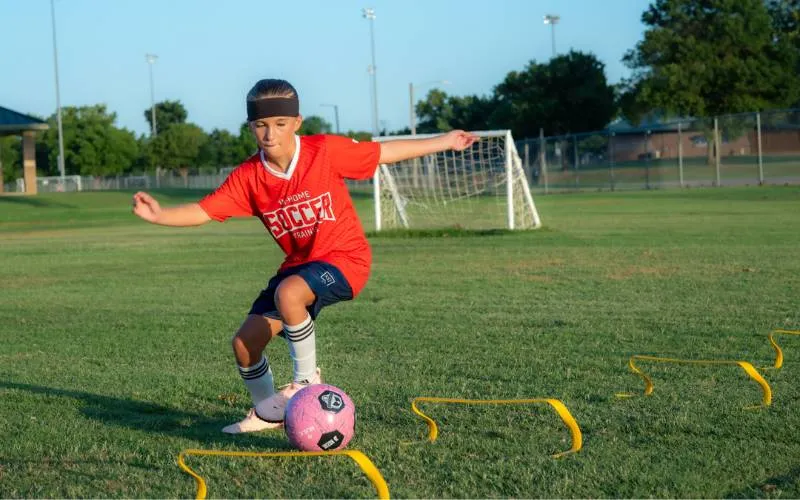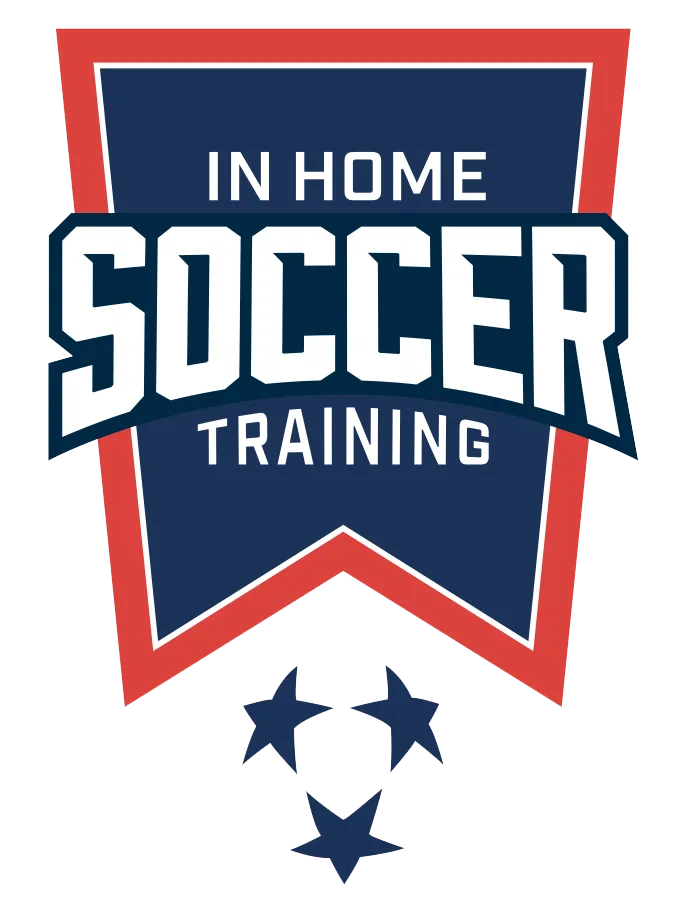Soccer footwork drills are training exercises that build ball control, agility, and confidence with the ball at your feet. They focus on improving how players move, react, and handle pressure during a game.
Footwork drills work by teaching players to control the ball through repeated touches, turns, and changes of direction. They can be done in small spaces, like a backyard or driveway, with just a ball and cones. Strong footwork helps players stay balanced, make faster decisions, and keep possession under pressure.
In this guide, you will learn what soccer footwork drills are, the benefits they provide, and how much to practice at different ages and skill levels. It will explain how to progress in footwork skills, and how these drills can help children in their soccer training by transferring practice into real-game scenarios.

Table of Contents
What are Soccer Footwork Drills?
Soccer footwork drills teach kids to handle the ball with balance, control, and speed. They focus on touches, turns, and changes of direction, which are essential skills for every player in real games. Footwork drills doesn’t require big area, it can be done in the driveway, backyard, or indoors with a ball and cones. For children aged 7–13, this training can be very effective.
U.S. Soccer, in its player development framework, calls this the “golden learning stage,” because coordination and agility develop fastest at this age. It’s the best time to focus on skills like footwork to perform like a professional.
Check out the video below by William Nozak, explaining the footwork combination by Lamine Yamal and a simpler version for competitive soccer players.
What are the Benefits of Soccer Footwork Drills?
Footwork drills build coordination, quick reactions, and sharper decision-making, giving players an advantage on the field. The main benefits are: Better Ball Control, Improved Agility and Quick Reactions, More Speed and Coordination, and Confidence under Pressure.
- Better Ball Control
The more you practice footwork, the easier it gets to move the ball in any direction without losing control. - Improved Agility and Quick Reactions
Footwork drills help players maintain balance and react quickly to defenders, which is why many academies prioritize change-of-direction and balance exercises. - More Speed and Coordination
Quick feet mean faster play. By practicing steady, controlled touches, players train their body and mind to work together. - Confidence under Pressure
Footwork drills give players control over the ball, helping them stay calm in challenging situations. This control lets them make better decisions and handle pressure from defenders. Mastering footwork helps players perform confidently even under intense pressure.
How Much Should You Practice Soccer Footwork Drill Per Day?
Practice footwork drills for 10–20 minutes daily on your own, and extend your training time when taking part in team or group sessions.
Many coaches recommends about 20 minutes of individual technical work each day to improve skills like dribbling, first touch, and control.
How Much Should an Adult Practice Soccer Footwork Drill Per Day?
Adults should aim for 30–45 minutes of footwork drills per day when training on their own. This is enough time to build skill and intensity while staying focused and avoiding burnout. Adults can handle slightly more training than kids because they generally have better strength and endurance.
For kids or adults who play for fun or in local teams, a full practice including warm-ups, fitness, and team drills usually lasts 1–2 hours. But for footwork – ball control, agility – just 30 minutes of focused practice is enough.
How Much Should Youth Practice Soccer Footwork Drill Per Day?
Girls and boys should practice footwork drills every day for 10–20 minutes on their own. Coaches may also include longer team or group sessions, adjusting the time, intensity, and feedback to suit each child’s age, confidence, and skill level.
Home practice can complement academy sessions. Simple drills such as cone ladder exercises and ball control routines in a backyard or driveway for 10-15 minutes will improve coordination, balance, and touch.
Most drills are the same for girls and boys of ages under 13. What matters is how they are practiced and how consistently they are practiced.
Level Up Footwork Skills Step by Step
Every great player starts with quick feet. Our Pathways guide takes young athletes from simple balance and coordination drills to advanced footwork patterns that sharpen speed, agility, and ball control.
How a Beginner Soccer Footwork Drill Should Look Like?
A beginner footwork drill should be short, simple, and focused on basic ball control. The goal isn’t speed, but getting comfortable with the ball and learning balance and coordination. A good starting routine is about 5–7 minutes long warm-up.
Two of the best beginner drills are:
- Toe Touches: Stand over the ball and lightly tap the top of it with alternating feet. Start slow, then go faster once you feel balanced. This builds coordination and helps you stay in control while moving.
- Sole Rolls: Place the ball under your foot and gently roll it from side to side using the sole (bottom) of your foot. You can set up two cones a few yards apart and move the ball between them. This teaches smooth movement and rhythm with the ball.
How an Intermediate Soccer Footwork Drill Should Look Like?
An intermediate footwork drill should last about 7–10 minutes and focus on rhythm, control, and quicker movements than beginner drills. At this stage, kids start linking different touches and practicing patterns that are closer to real-game situations.
A great drill is the inside-outside cone drill. Place five or six cones in a line, about a yard apart. Dribble in a zigzag pattern, using the inside and outside of each foot on every touch. Keep the ball close and stay balanced. Once comfortable, players can slowly increase speed while maintaining control.
Another useful drill is the touch, touch, roll drill. Tap the ball once with the right foot, then once with the left, and roll it to the side with the sole of your foot. Repeat while moving between cones. This helps kids combine different touches and stay in control, which is essential for quick adjustments during a game.
How an Advanced Soccer Footwork Drill Should Look Like?
An advanced footwork drill should take 10–15 minutes and focus on quick touches, fast reactions, and control at high speed. At this stage, players already know the basics, so drills should challenge their skills and push their limits.
One example is the inside-outside left/right Drill. Players dribble using inside and outside touches with one foot, then switch to the other. The focus is on staying balanced, keeping touches clean, and gradually increasing speed.
Another effective exercise is alternating kick-arounds. Players roll or push the ball slightly, circle their foot around it, then trap it again. Switching feet keeps both sides strong and builds quick coordination.
These drills are more advanced-level and help players stay in control and move faster and more easily in tight spaces.
How Soccer Footwork Drills Help Children with Their Soccer Training
Footwork drills help children improve ball control, agility and teaches them to keep the ball close, turn quickly, and react fast.
To progress in footwork skills, start slow, focus on getting your technique right, then gradually add speed. Practice with both feet, follow a step-by-step plan, and test your skills in game-like situations.
- Start Slow and Master the Basics: When learning a new drill, go slowly. Focus on clean touches, balance, and moving your body correctly with the ball. Once comfortable, increase your speed gradually. This approach follows the U.S. Soccer Federation’s child soccer development framework by focusing on helping young players develop basic movement skills, coordination, and ball control.
- Add Speed Gradually: Practice control first, then go faster once you can touch the ball properly.
- Practice with Both Feet: Many kids rely on their stronger foot. Practice drills with both feet to build balance and versatility, making you a well-rounded player.
- Step 1 → Easy drills with no pressure
- Step 2 → Increase pace
- Step 3 → Add defenders or reaction challenges
- Step 4 → Apply skills in full game situations
A structured approach keeps you improving without getting stuck.
- Set Small Goals: Big improvements come from small wins. For example, dribble through cones using your weaker foot, or try to complete a drill a little faster each week.
- Test Your Skills in Games: Footwork matters most under pressure. Use drills in 1v1 battles, small-sided games, or scrimmages. Practicing in real situations helps kids react quickly and play confidently.
Not Sure Which Program Fits Your Child?
If you’re unsure which pathway is right for your child’s age or experience, our Kids’ Guide makes it simple.
What Equipment Is Used for Soccer Passing Drills?
To practice soccer footwork drills effectively, you only need a few at-home sports equipment:
- Soccer Ball: The main tool for all drills and exercises.
- Cones or Markers: Used to set up dribbling patterns, agility paths, and practice zones.
- Agility Ladder: Helps improve quick foot movement and coordination.
- Training Bibs: Useful when practicing in groups or for small-sided games.
- Flat Space (Grass, Turf, or Driveway): A safe surface to perform drills.
- Optional: Stopwatch: To time drills and track progress.

